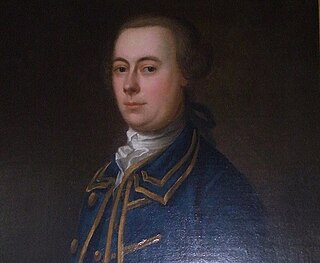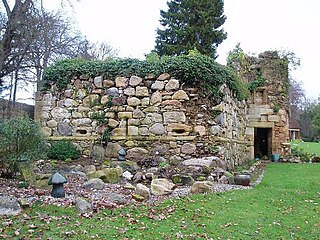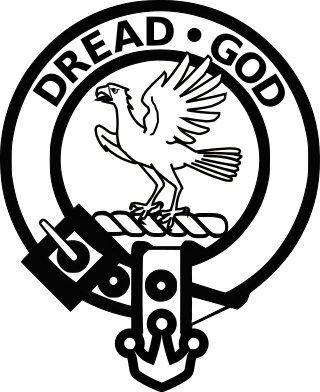Related Research Articles

Clan Mackay is an ancient and once-powerful Highland Scottish clan from the far North of the Scottish Highlands, but with roots in the old Kingdom of Moray.

Sir Harry Munro, 7th Baronet was 25th Baron and the 28th chief of the Clan Munro. He was a Scottish soldier and politician. He was loyal to the Hanoverian dynasty and served as a captain in Loudon's Highlanders Regiment 1745–48.
Colonel Robert Munro of Foulis, also known as the Black Baron, was traditionally the 18th Baron of Foulis in Scotland. He was a soldier of fortune, who served in Germany under the banners of Gustavus Adolphus, king of Sweden. It is not certain how he got his epithet of the 'Black Baron', but quite possibly it was from the colour of his hair rather than any perceived martial ferocity. Although this Robert Munro is traditionally 18th Baron and 21st overall chief of the Clan Munro, he is only the 11th Munro chief that can be proved by contemporary evidence.
Sir Robert Munro, 5th Baronet of Foulis was also 23rd Baron and 26th chief of the Clan Munro. He became blind and was known as the Blind Baron.
Donald Mackay, 1st Lord Reay, 14th of Strathnaver was a Scottish soldier and member of Parliament. He played a prominent role in the Thirty Years' War, raising a regiment of 3,000 men, which served in both the Danish and Swedish forces. He was later an unwilling Covenanter. He was the fourteenth chief of Clan Mackay, a Highland Scottish clan.

Sir George Munro, 1st of Newmore (1602–1693) was a 17th-century Scottish soldier and member of parliament from the Clan Munro, Ross-shire, Scotland. He was seated at Newmore Castle. Between 1629 and 1634 Munro held command in the Swedish army during the Thirty Years' War, and from 1642 in the Scottish Covenanter army during the Irish Confederate Wars before changing his allegiance to the Royalist cause of Charles I in 1648 during the Scottish Civil War and Irish Confederate Wars.
Robert Mor Munro, 15th Baron of Foulis, and 18th chief of the Clan Munro was a 16th-century Scottish chief. He was known as Robert Mor on account of his large stature. He was the eldest son of Robert Munro, 14th Baron of Foulis. Although this Robert Munro is traditionally 15th Baron and 18th overall chief of the clan, he is only the 8th Munro chief that can be proved by contemporary evidence.
Sir Robert Munro, 3rd Baronet of Foulis, 21st Baron and 24th chief of the Clan Munro was a 17th-century Scottish soldier and politician.
Robert Munro, 14th Baron of Foulis was a Scottish soldier and clan chief of the Highland Clan Munro. He was seated at Foulis Castle. Although he is traditionally the 14th Baron and 17th overall chief of the clan, he is only the 7th Munro chief that can be proved by contemporary evidence.

The chiefs of the Scottish highland Clan Munro, the Munros of Foulis, are according to tradition, descended from a Donald Munro of Foulis who died in 1039. However, their descent can only be proved by contemporary evidence back to a Robert de Munro who died in 1369.
Sir Hector Munro, 2nd Baronet of Foulis was a Scottish noble and clan chief of the highland Clan Munro. He is also by tradition the 20th Baron and 23rd overall chief of the clan. However, he is actually the 13th chief of the Clan Munro who can be proved by contemporary evidence.

The Munros of Obsdale were a Scottish family and a cadet branch of the Clan Munro, a Highland Scottish clan. Their base was at Obsdale House, situated just north of the town of Alness in the Scottish Highlands. Some of the members of the Munro of Obsdale family were amongst the most distinguished Scottish military officers of the 17th century.

Clan Munro is a Highland Scottish clan. Historically the clan was based in Easter Ross in the Scottish Highlands. Traditional origins of the clan give its founder as Donald Munro who came from the north of Ireland and settled in Scotland in the eleventh century, though its true founder may have lived much later. It is also a strong tradition that the Munro chiefs supported Robert the Bruce during the Wars of Scottish Independence. The first proven clan chief on record however is Robert de Munro who died in 1369; his father is mentioned but not named in a number of charters. The clan chiefs originally held land principally at Findon on the Black Isle but exchanged it in 1350 for Estirfowlys. Robert's son Hugh who died in 1425 was the first of the family to be styled "of Foulis", despite which clan genealogies describe him as 9th baron.

The Skirmish of Alness was a conflict that took place in October 1715 in Alness, in the county of Ross in the Scottish Highlands. It was part of the Jacobite rising of 1715 and pitted Highlanders loyal to the British-Hanoverian Government of George I of Great Britain against Highlanders loyal to the Jacobite House of Stuart.
Hector Munro, 17th Baron of Foulis, also known as the master of Foulis, was a Scottish chief of the Highland, Scottish clan, Clan Munro. He is the 10th chief of Clan Munro who can be proved by contemporary evidence. He was seated at Foulis Castle.
John Munro, 2nd of Lemlair was a Scottish soldier who fought as a colonel in the Wars of the Three Kingdoms. His seat was at Lemlair House.

The Mackays of Scoury were a minor noble Scottish family and a branch of the ancient Clan Mackay, a Highland Scottish clan. They were seated at Scourie Castle, in Scourie, in the parish of Eddrachillis, county of Sutherland. However, Scourie was part of the Mackay chief's province of "Strathnaver" until it was sold to the Earl of Sutherland in 1829.
Angus Roy Mackay, 9th of Strathnaver, was the ninth chief of the ancient Clan Mackay, a Scottish clan of the Scottish Highlands.
The Munros of Kiltearn were a minor noble Scottish family and a branch of the ancient Clan Munro, a Scottish clan of the Scottish Highlands.They were seated at Kiltearn House which was a manor house that shared the same name of the parish it was situated in, Kiltearn. In Scottish Gaelic the Munros of Kiltearn are known as the Sliochd-Alastair-Mhic-Uistean. The most famous member of the Munro of Kiltearn family was Donald Monro, High Dean of the Isles.
Lachlan Mor Mackintosh, 16th of Mackintosh was the chief of the Clan Mackintosh, a Scottish clan of the Scottish Highlands. He was also chief of the confederation of clans that was known as the Clan Chattan.
References
- 1 2 3 4 5 6 7 8 9 10 11 12 13 Mackenzie, Alexander (1898). History of the Munros of Fowlis. Inverness: A. W Mackenzie. pp. 83-86. Retrieved 15 April 2020.
- ↑ Munro, R.W (1978). The Munro Tree 1734. Edinburgh. ISBN 0-9503689-1-1.
{{cite book}}: CS1 maint: location missing publisher (link) - ↑ Fraser, C.I of Reelig (1954). The Clan Munro. Stirling: Johnston & Bacon. p. 25. ISBN 978-0-7179-4535-1.